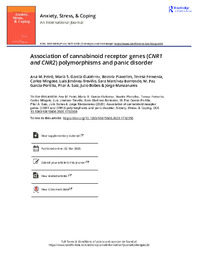Title:
Association of cannabinoid receptor genes (CNR1 and CNR2) polymorphisms and panic disorder |
Authors:
Peiró, Ana
García Gutiérrez, María Salud
Planelles, Beatriz
Femenía Cantó, Teresa
Mingote, Carlos
Jiménez Treviño, Luis
Martínez Barrondo, Sara
García Portilla, M. Paz
Saiz, Pilar A.
Bobes, Julio
Manzanares, Jorge |
Editor:
Taylor & Francis |
Department:
Departamentos de la UMH::Farmacología, Pediatría y Química Orgánica |
URI:
https://hdl.handle.net/11000/35354 |
Abstract:
Background and objectives: Panic disorder (PD) is an anxiety disorder
characterized by recurrent and unexpected panic attacks along with
sudden onset of apprehension, fear or terror. The endocannabinoid
system (ECS) has a role in stress recovery, regulating anxiety. The aim of
this study was to ana... Ver más
|
Keywords/Subjects:
Panic disorder
panic attacks
CNR1
CNR2
FAAH
single nucleotide polymorphism |
Knowledge area:
CDU: Ciencias aplicadas: Medicina: Farmacología. Terapéutica. Toxicología. Radiología |
Type of document:
info:eu-repo/semantics/article |
Access rights:
info:eu-repo/semantics/openAccess
Attribution-NonCommercial-NoDerivatives 4.0 Internacional |
DOI:
10.1080/10615806.2020.1732358 |
Published in:
Anxiety, Stress and Coping, 2020;33(3):256-265 |
Appears in Collections:
Artículos Farmacología, Pediatría y Química Orgánica
|

.png)
